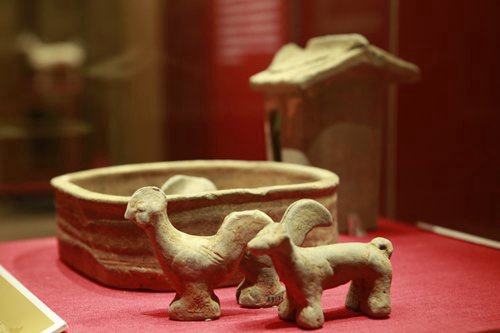
In Chinese culture the dog is known not only for its fidelity but also as a guardian of peace in the underworld, exhibits suggest at the Best Wishes from the Auspicious Dog exhibition in Beijing.
To mark the upcoming Year of the Dog, a collection of dog relics is on display at the Capital Museum starting Friday, including a traditional 12-section pingfeng folding screen featuring Qing Dynasty (1644-1911) nobles and their hounds as well as a life-size marble dog tomb sculpture unearthed from the Old Summer Palace that attracted waves of visitors on its opening day.
A replica of the copper dog head sculpture - part of an Old Summer Palace fountain that went missing when British and French troops looted the royal garden in 1860 - was installed at the exhibition entrance against a wall of festive red lanterns.
"My little girl's zodiac animal is a dog and so I brought her here to get to know more about the animal," a Beijing mother surnamed Zhang told the Global Times at the exhibition. "Before the show, I didn't know that a dog carried so many meanings in ancient Chinese history and culture."
Reliable companion
By exploring artworks and archaeological discoveries since prehistoric times, the exhibition unfurls its implications as a zodiac animal as well as its relationship with Chinese people over the past 2,000 years via relics, documents and pictures.
Whether hounds chasing quarry in Tianshan Mountain prehistoric cave frescos, zodiac symbols in ancient paintings or pets cuddled by fat Tang (618-907) and Qing Dynasty ladies on scroll paintings, dogs have appeared as helpers and companions throughout Chinese popular history.
It makes sense as archeological discoveries show dogs among the first animals to be domesticated by the forefathers in China.
Chinese people's love for the animal can also be seen in dog jade accessories and decorative sculptures at the exhibition.
As jade traditionally wards off bad luck and possesses pure and beautiful qualities beloved by Chinese nobility, a jade dog pendant made a perfect amulet.
Craftspeople created exquisite dog-shaped locks during the Republic of China (1912-1949). Lock makers trying to impress buyers with their delicate designs also seemed to be exploring the animal's image as a guardian.
Suggesting the dog's role as companion in the underworld, Han Dynasty (206 BC-220 AD) and Qing tombs feature palm-size ceramic and jade sculptures.
"In ancient Chinese tombs, the image of a dog often appears with a rooster probably due to the widely-accepted conception of 'rooster rules the morning, dog guards the night,' which might help inform the tomb owners of that time and bring peace," reads the exhibition Chinese language introduction.
As part of the museum's lunar new year celebrations, the show is scheduled to run until March 18, free of charge. Dogs are not admitted.



